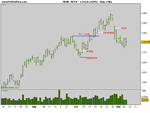barjon
Legendary member
- Messages
- 10,752
- Likes
- 1,863
I have been trading (amateur) since the dark ages and I've never varied my strategy - potential trend continuation after retracement - albeit that I've used many different entry set-ups over the years. In fact, I'd say most of my thinking was devoted to such set-ups and very little to exits.
How I wish now that I had reversed that thinking since, whilst a good entry is important, it's knowing when to exit that is crucial to the bottom line.
Stop-losses have never been a problem. I hate seeing a losing trade in my account and ditch them without compunction (I do think a re-entry set-up is worth establishing, though, to cover those odd irritations of the damn thing turning round and zooming off in the direction you wanted in the first place).
No, the real problem over the years has been taking profits. I've done it all: watching healthy profits come back to break even trades; taking profits and jumping off the train just before it picks up speed; being shaken out by what's going on in a lower time frame; or ignoring what my trading time frame is saying and staying in because the higher time frame still looks ok; etc;etc. You name a fault and I've been guilty of it.
Have I overcome the problem? Well, certainly I'm a lot better than I was and I am far more well prepared. In essence, I believe you can live with a single entry set-up, but that there should be several exit set-ups in your tool box and a well thought out re-entry strategy. Most of all, I now spend far more time planning my exits than I do my entries.
good trading
jon
How I wish now that I had reversed that thinking since, whilst a good entry is important, it's knowing when to exit that is crucial to the bottom line.
Stop-losses have never been a problem. I hate seeing a losing trade in my account and ditch them without compunction (I do think a re-entry set-up is worth establishing, though, to cover those odd irritations of the damn thing turning round and zooming off in the direction you wanted in the first place).
No, the real problem over the years has been taking profits. I've done it all: watching healthy profits come back to break even trades; taking profits and jumping off the train just before it picks up speed; being shaken out by what's going on in a lower time frame; or ignoring what my trading time frame is saying and staying in because the higher time frame still looks ok; etc;etc. You name a fault and I've been guilty of it.
Have I overcome the problem? Well, certainly I'm a lot better than I was and I am far more well prepared. In essence, I believe you can live with a single entry set-up, but that there should be several exit set-ups in your tool box and a well thought out re-entry strategy. Most of all, I now spend far more time planning my exits than I do my entries.
good trading
jon

